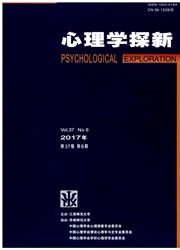

 中文摘要:
中文摘要:
本文采用停止信号范式,对停止信号范式是否适用于未成年犯,以及未成年犯与中学生的抑制控制能力是否有差异进行了研究。结果发现,未成年犯的信号反应概率随着停止信号延迟(SSD)的增加而增加;未成年犯在停止信号反应时(SSRT)上比中学生要显著地长,而在无信号反应时(NSRT)上比中学生要显著地短。结果表明,停止信号范式适用于未成年犯;未成年犯的抑制控制能力比中学生差。
 英文摘要:
英文摘要:
The current study used the stop- signal paradigm to investigate inhibitory control of juvenile offenders and middle school students. The purpose of present study is to explore whether juvenile offenders are worse than middle school students on inhibitory con- trol. Two experiments were designed to investigate the inhibitory control of juvenile offenders and middle school students. The target of experiment 1 is whether juvenile offenders are suitable for the stop - signal paradigm, The purpose of experiment 2 is comparing the in- hibitory control of juvenile offenders and middle school students. Result of experimentl shows that juvenile offenders' probabilities of responding on stop - signal trials increase w;th ~SD. Result of experiment 2 shows that juvenile offenders' SSRT is significantly longer than middle school students' ,but juvenile offenders' NSRT is significantly shorter than middle school students'. The results of two ex- periments indicate that stop- signal paradigm can apply to juvenile offenders;and inhibitory control of juvenile offenders is worse tha. that of middle school students.
 同期刊论文项目
同期刊论文项目
 同项目期刊论文
同项目期刊论文
 期刊信息
期刊信息
